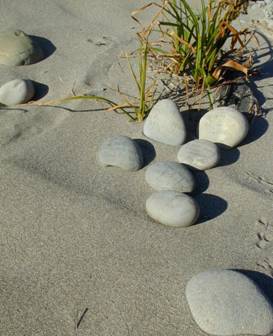 |
BARE BONES School of Haiku Jane Reichhold |
||||
|
As result of my working with the Mendocino County teachers and the Poet Laureate Committee of Ukiah, California, I have seen that though my book, Writing and Enjoying Haiku, has been very helpful to many people, in this new work I am discovering that there needs be a better way to teach haiku writing in schools. Before the folks at Kodansha asked me to write a how-to book for haiku in 2001, I had started preparing a series of lessons for what I then called the "Bare Bones School of Haiku." With the invitation from Kodansha the project was abandoned and the materials I had written were poured into the book. Now I am thinking that the idea of giving haiku writers interested in improving their skills a lesson plan may even be an easier way of finding just the subject matter they need, when and how they need it. Maybe the old idea of posting lessons had its advantages. So this is a return to the original idea. I sincerely hope it will prove helpful to you and to many others. Jane Reichhold
Japanese origin of the term Lesson Two How to read haiku, how to find haiku to read, and how to use what you read Where to look for inspiration for your haiku. Lesson Four Explaining the haiku form. Lesson Five The second-most vital aspect of a haiku. What your verbs reveal about you Lesson Seven
Lesson Eight To Be. or not to be Lesson Nine At last! in charge of your life and writing! Ha! did you know there were such things? Lesson Eleven Lessons from the Master Actually putting pen to paper with a check list Lesson Thirteen Your graduation is your first book How to make a sequence. The book needs this. | |||||
HOW TO USE THESE LESSONS Read the lesson through to see if anything in it interests you or applies to your current interest in haiku. Download the file into a word document and save all the files together in one directory. Or Print the lesson out on paper. You may print and give away as many copies as you wish as long as you do not sell them. Use the printouts or the downloaded files as worksheets, writing down your poems, your ideas, and even what you feel about what is said. Do save your files or worksheets. You may be surprised years later when you read again the lessons and your responses to find new ideas or understanding. It will be interesting to see how your haiku and your understanding of the form changes. Blessed Be!
Just got the good news today, June 14, 2012, that these lessons have been translated into Bulgarian and are available at: http://haikubg.wordpress.bg/ A huge thanks to Maya and her friends! |
|||||
Jane Reichhold has been combining her art and writing since her college days fifty years ago. Her latest book, by Kodansha International, is Basho The Complete Haiku. As founder and editor of AHA Books, Jane has also published Mirrors: International Haiku Forum, Geppo, for the Yuki Teikei Haiku Society, and she has co-edited with Werner Reichhold, Lynx for Linking Poets since 1992.. Lynx went online in 2000 in AHApoetry.com, the web site Jane started in 1995. She lives near Gualala, California with Werner, her husband, and a Bengal cat named Buddha.
|
Page and Materials Copyright © Jane Reichhold 2011. Please give credit when borrowing. |
||||
